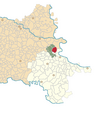Ćelije, Croatia
Ćelije | |
|---|---|
 | |
| Coordinates: 45°26′19″N 18°48′20″E / 45.4386°N 18.8056°E | |
| Country | |
| Region | Slavonia (Podunavlje) |
| County | |
| Municipality | Trpinja |
| Government | |
| • Body | Local Committee |
| Vehicle registration | VU |
Ćelije sometimes also referred to as Ćelija, is a village in eastern Croatia located west of Trpinja and south of the Osijek Airport. The population is 121 (census 2011).[1]
Name
The name of the village in Croatian is in the plural, and therefore it is grammatically correct to refer to it as "Ćelije are" instead of "Ćelije is". A hypothetical and sometimes used singular version of the name would be Ćelija.
History
Croatian War of Independence
On 7 July 1991, during the initial stages of the Croatian War of Independence, the Yugoslav People's Army (JNA) and SAO Krajina militia forced evacuation of the ethnic-Croat population of the village—180 residents. The evacuation happened in the aftermath of a JNA tank and mortar attack on the Croatian National Guard (ZNG) on 4 July,[2] resulting in death of three ZNG troops. The confrontation was over control over Ćelije. Several days after the evacuation, the village was torched—the first such instance in the war.[3]
Eleven civilians killed in Erdut by SAO Krajina authorities in early November 1991 were buried in a mass grave in Ćelije. As of July 2013[update], Goran Hadžić, one of Croatian Serb political leaders at the time, is on trial at the International Criminal Tribunal for the former Yugoslavia. Hadžić faced charges related to the killings and other war crimes committed in 1990s but died before a verdict could be reached.[4]
UNTAES protectorate and subsequent period
Ćelije were left in ruins until 1998, when a part of the refuged population returned, upon return of the area to Croatian control through the Erdut Agreement, at the end of the United Nations Transitional Administration for Eastern Slavonia, Baranja and Western Sirmium mandate.[2] That year, a mass grave containing victims killed after capture of the village was destroyed near the village,[5] and a total of 32 sets of human remains were recovered in the village by 2012. Since 2002, a 22-kilometre (14 mi) memorial procession is held annually through Tordinci, Antin, Ćelije and Korog—villages where mass graves of 266 Croatian soldiers and civilians were found after the war.[6]
In 2011, Croatian authorities opened an investigation against Boro Ivanović, commanding officer of the JNA 12th Proletarian Mechanised Brigade in 1991, in connection with 1991 expulsion of population and destruction of the village.[7]
See also
References
- ^ "Population by Age and Sex, by Settlements, 2011 Census: Ćelije". Census of Population, Households and Dwellings 2011. Zagreb: Croatian Bureau of Statistics. December 2012.
- ^ a b Flego, Miroslav (7 July 2011). "Prije točno 20 godina protjerali ih iz Ćelija i spalili selo" [Exactly 20 years ago they were banished from Ćelije and the village was torched]. Večernji list (in Croatian).
- ^ "20. godišnjica stradanja Ćelija" [20th Anniversary of Destruction of Ćelije] (in Croatian). tportal.hr. HINA. 7 July 2011.
- ^ Pavić, Snježana (16 October 2012). "Hadžić se smijao u sudnici! Tužitelj: 'Išli ste u Beograd po oružje i bili Miloševićev čovjek na terenu'" [Hadžić lauged in the courtroom! Prosecutor: 'You went to Belgrade to get the weapons and were Milošević's main in the field']. Jutarnji list (in Croatian).
- ^ "Vukovar: Ekshumirano 25 tijela i otkrivena nova grobnica kraj Ćelija" [Vukovar: 25 bodies exhumed and a new grave adjacent to Ćelije found] (in Croatian). Croatian Radiotelevision. 9 October 1998.
- ^ Miroslav Flego. "Tisuću hodočasnika na Križnom putu "Putem masovnih grobnica"" [A Thousand Pilgrims in Mass Graves Procession]. Večernji list (in Croatian).
- ^ Lepan, Suzana. "Odvjetništvo traži proširenje istrage protiv Bore Ivanovića" [State Attorney's Office requested inquiry of Boro Ivanović]. Večernji list (in Croatian).



